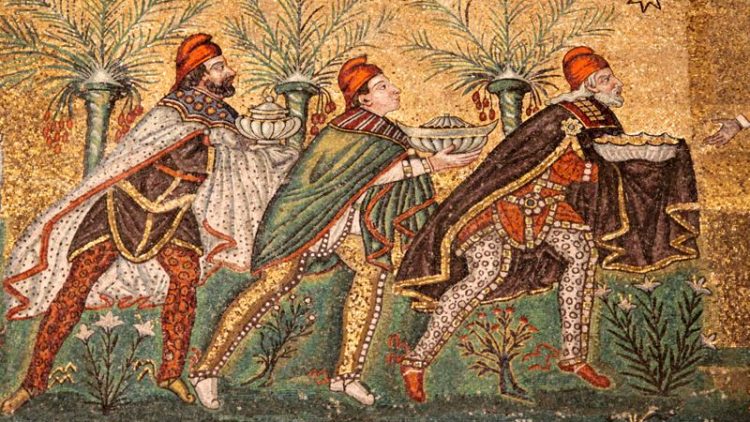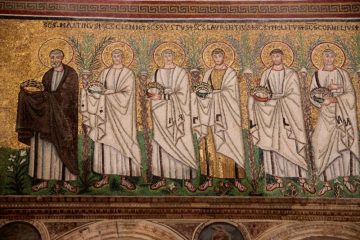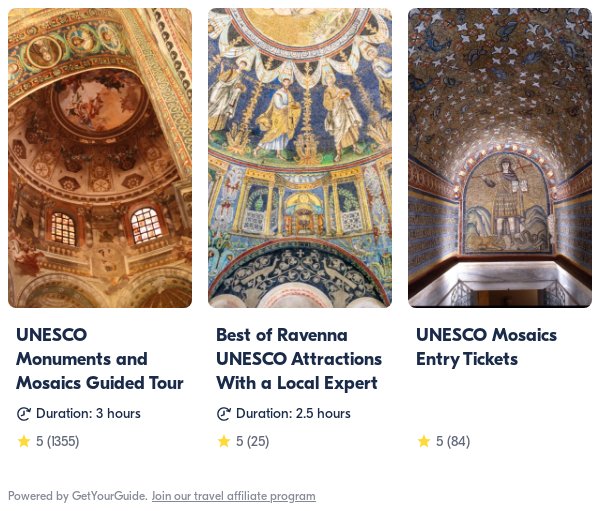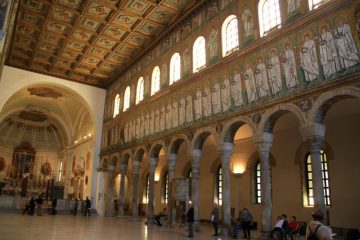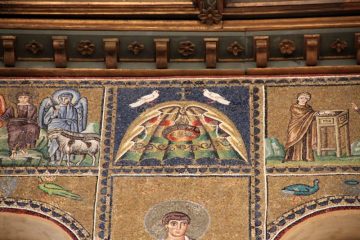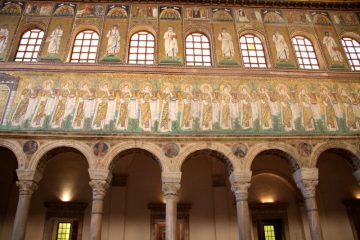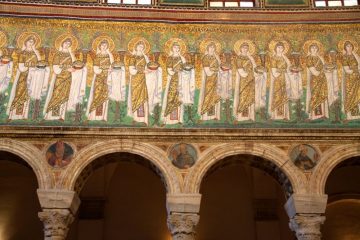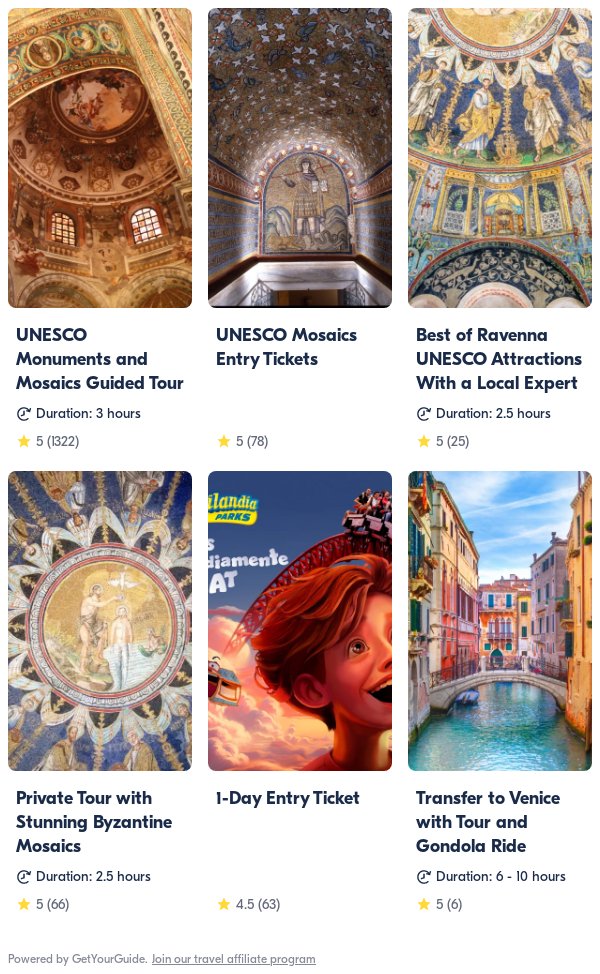The UNESCO World Cultural Heritage-listed Church of Sant’Apollinare Nuovo has some of the most impressive and interesting Late Antiquity and Byzantine mosaics in Ravenna, Italy.
The Basilica of Sant’Apollinare Nuovo is one of the top sights to see when visiting Ravenna near Venice and Bologna. Ravenna has eight UNESCO World Cultural Heritage-listed sites of major early Christian monuments and Byzantine mosaics with this church amongst the most interesting. Sant’Apollinare Nuovo was the palatine church of the Ostrogoth King Theodoric the Great and thus adds interesting historical side notes to the art of the magnificent wall mosaics.
The Basilica of Sant’Apollinare Nuovo in Ravenna
The church of Sant’Apollinare Nuovo is an early-sixth-century basilica, originally serving as the palatine church of the Ostrogoth King Theodoric. It was originally dedicated as an Arian church to Christ the Redeemer. In 561, it was re-dedicated as a Roman Catholic Church to St Martin of Tours and in 856, as Sant’Apollinare Nuovo after the remains of the saint were moved from the similarly named church in Classe.
- For more on Theodoric the Great and Arianism in Ravenna see The Arian Baptistery.
The exterior of the church is rather plain and unremarkable apart from a rather attractive 38-m high cylindrical campanile of Ottonian design erected probably in the tenth century. The simple marble arcade is from the sixteenth century when many of the mosaics in the church were destroyed.
In contrast to the Basilica of San Vitale, which is almost entirely eastern in appearance, the Basilica of Sant’Apollinare Nuovo shows an interesting fusion of eastern and western style influences. The mosaics are clearly Byzantine in character while the long nave (42 x 21 m) without transept is more typical Italian in style.
The Mosaics of the Basilica of Sant’Apollinare Nuovo
The interior of the Basilica of Sant’Apollinare Nuovo is almost bare, which helps to draw attention to the overwhelming mosaics on the upper lateral walls on both sides of the nave.
Even though a large number of mosaics in the Basilica of Sant’Apollinare Nuovo were lost through the centuries, the remaining artworks are amongst the most impressive mosaics in the world. Originally, mosaics would have covered most of the interior but many were lost in earthquakes, wars, building alterations, and botched restoration attempts.
The surviving mosaics cover the lateral walls of both sides of the nave. Art historians argue about the exact dating of some mosaics but almost all are at least from the sixth century. The question is just which part – before or after Theodoric?
Looking from the top down, the mosaics in Sant’Apollinare Nuovo in Ravenna may be divided into three horizontal bands:
The upper band, above window level, dates from the reign of Theodoric the Great, and shows in thirteen panels on each side of the nave miracles from the life of Christ (left wall) and the Passion (right wall). Typically Arian, Christ is still beardless on the left wall. This is less common in the orthodox tradition but not unknown. Other Arian symbols were removed when the basilica became Roman Catholic.
- For a more detailed description see Sacred Destinations.
The middle band shows biblical figures alternating with windows. As with the upper band, these mosaics date from the time of Theodoric the Great and are in the Greek-Roman style of individualistic facial features in addition to each figure being shown with different items and symbols.
The lower band is more Byzantine in style with figures lacking individuality and mostly dates from around half a century later. By this time, Arianism was outlawed and the church already Orthodox (Roman Catholic) and rededicated to Saint Martin of Tours.
On the left wall, the mosaics feature a procession of 22 virgins led by the Three Kings / Magie from the port of Classe towards the Madonna with Child. On the right wall, 26 martyrs are led from the Palace of Theodoric towards Christ surrounded by angels. Christ previously carried a book but restoration work in 1860 replaced it with a scepter.
Note the curtains in the Palace of Theodoric – after Byzantium took direct control of Ravenna, references to Theodoric and his time were removed and replaced by these curtains – some pillars still feature the original hands that were not tiled out.
(The nearby attraction of the ruins of Theodoric’s Palace is now considered to be the ruins of a church rather than the famously sumptuous palace of the Ostrogoth king.)
Visiting the Basilica of Sant’Apollinare Nuovo
The Basilica of Sant’Apollinare is located just a few blocks from the train station to the west of the town center. If walking to and from other top sights, it is easy to see the tomb of Dante and the Arian Baptistry en route.
See Visiting UNESCO-Listed Sights in Ravenna for opening hours and ticket information.
NEXT: Basilica of San Vitale
More Articles on Ravenna, Italy
Time-slot reservations are currently essential to see the Mausoleum of Galla Placida and the Neonian Baptistry in Ravenna. This is easiest done when buying the tickets online.
- Top Sights to See in Ravenna
- UNESCO-Listed Sites in Ravenna
- Visiting UNESCO-Listed Sites in Ravenna – Opening Hours and Tickets
- The Neonian Baptistery & Archbishop’s Chapel
- The Arian Baptistery
- Basilica of Sant’Apollinare Nuovo
- Basilica of San Vitale
- Mausoleum of Galla Placidia
- Mausoleum of Theodoric
Book Guided tours of Ravenna — tours are generally three hours. For tours not including admission fees, around €12 per person must be added. Small groups and families may find better value in private tours.
